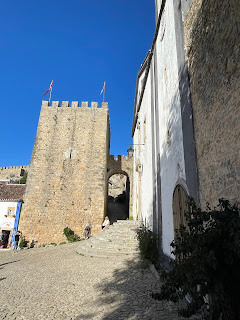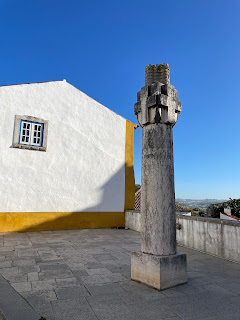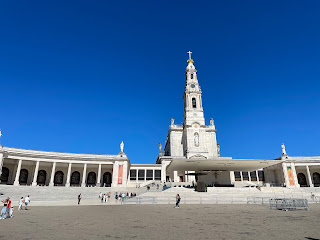Oy! Just a day into this tour and I'm exhausted. My body is reminding me just how out of shape I am. I spent most the night dealing with leg cramps. Two things; dehydrated and out of shape! Today I need to find some electrolytes to hopefully help with the cramp thing.
We left Lisbon on our ultimate destination of Tomar. But before we get there we have several stops we have to make. I had a feeling I'd be as exhausted as I was after the Lisbon tour.
Life on a group tour is not for the faint at heart. You're with these same people for 10 days. 40 of them. You hope that they are all pleasant and that you can spend so much time with the same people. We all know that can be a challenge for me. Our tour group was made up of 5 couples from Utah (well one of the couples was from Seattle) that had traveled together for years. And then another large group of 10 ladies from Canada. I was worried they'd be clique-ish and difficult to get to know. Turned out that was not the case. The Utah group had the most annoying Know-it-all; adult frat boy that existed. And unfortunately, he was next to us on the bus the entire time.
You get a bus that Globus owns and maintains. As you enter the bus each day your name is on a list of where you sit. They rotate the seats so that everyone has a sense of getting a better seat.
First stop, Obidos.
What a quaint little village Obidos was. Though, I'll admit, it might not even be on the map if not for tourists. While it was full of small cobblestoned alley ways that lead to who knows what, it definitely felt like it was designed specifically for tourism. Regardless, I loved it.
The Interwebs: The area of the town of Óbidos is located on a hilltop, encircled by a fortified wall. Óbidos remains a well-preserved example of medieval architecture; its streets, squares, walls and its castle are popular tourist destinations.
We entered the walled city through this arch way that opened into a room with some beautiful tile work.
Hassan, our Globus tour guide, walked us to the center of Obidos to orientate us to the town and then let us have free time for a couple of hours. That gave Janet and I enough time to wander through the streets.
Janet and I took the "high" road and headed up to see the castle section of the city. There really wasn't much to see up there, but we did get some amazing views and, oddly, found they had crabs too.
The rest of our time we spent walking up and down the two main roads, stopping into shops as we went. |
| The Church of Santa Maria |
 |
| This little fella looked so relaxed on top of a car. I wanted to pet him, but as I got closer and put my hand out, this was the look on his face. I choose to not pet him. |
We left Nazare and headed to Alcobaca (Al-Co-Boss-ah) to visit one of the many monasteries. Upon arrival, however, there was a wedding going on in the chapel and we weren't allowed to go in. Bummer really. Instead, we were given more free time to have lunch.
This particular lunch was amazing. Trying to order it was an adventure considering the owner of the cafe didn't speak English and we didn't speak Portuguese. Still Janet managed to get "ham and cheese" out and then pointed to a bread to us. Delicious.From here we headed Fatima. In Fatima we'd be touring the main pilgrimage area. Fatima is one of the many pilgrimages that are done in Europe for the devout. I didn't really know what to expect, and I can tell you, it was not at all what I expected.
Interwebs: Fátima was named for a
12th-century Moorish princess, and since 1917 it has been one of the
greatest Marian shrines in the world, visited by thousands of pilgrims
annually.
On May 13, 1917,
and in each subsequent month until October of that year, three young peasant
children, Lucia dos Santos and her cousins Francisco and Jacinta
Marto, reportedly saw a woman who identified herself as the Lady of the
Rosary. On October 13, a crowd (generally estimated at about 70,000) gathered
at Fátima witnessed a “miraculous solar phenomenon” immediately after the lady
had appeared to the children. After initial opposition, the bishop of Leiria on
October 13, 1930, accepted the children’s visions as the appearance of the Virgin
Mary; in the same year, papal indulgences were granted to pilgrims.
The
first national pilgrimage to Fátima took place in 1927, and the basilica was
begun in 1928 and consecrated in 1953. With a tower 213 feet high,
surmounted by a large bronze crown and a crystal cross.
While we were there, we witnessed much of the devotion that is here. I, myself, do not understand this type of belief or the strength of the devotion, but I respect it and am humbled by seeing it.
At the Fatima Shrine in the Cova da Iria candles are lit every evening for the procession and there is a bank of lit candles near the side of the little chapel that marks the spot of Mary's apparitions in 1917. Many miracles have been recorded at the Cova which occurred during pilgrimages.



































0 comments:
Post a Comment